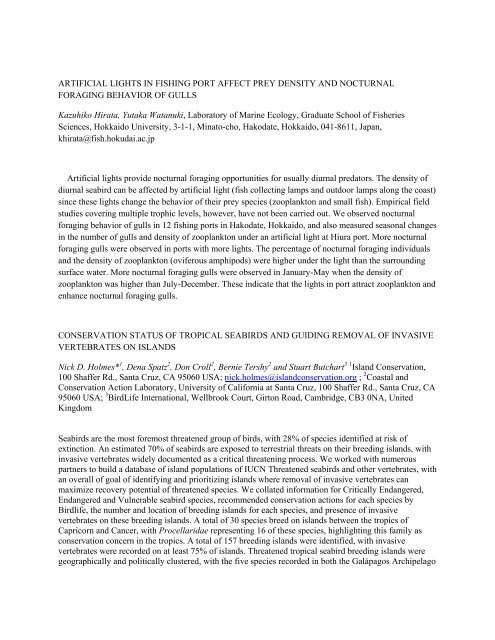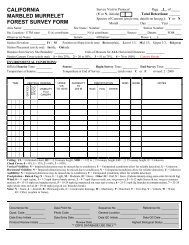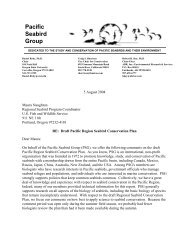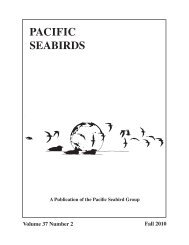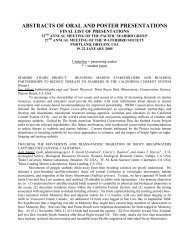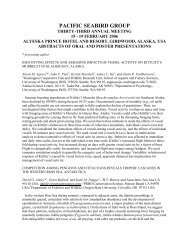PSG 2012 Hawaii abstracts - Pacific Seabird Group
PSG 2012 Hawaii abstracts - Pacific Seabird Group
PSG 2012 Hawaii abstracts - Pacific Seabird Group
You also want an ePaper? Increase the reach of your titles
YUMPU automatically turns print PDFs into web optimized ePapers that Google loves.
ARTIFICIAL LIGHTS IN FISHING PORT AFFECT PREY DENSITY AND NOCTURNAL<br />
FORAGING BEHAVIOR OF GULLS<br />
Kazuhiko Hirata, Yutaka Watanuki, Laboratory of Marine Ecology, Graduate School of Fisheries<br />
Sciences, Hokkaido University, 3-1-1, Minato-cho, Hakodate, Hokkaido, 041-8611, Japan,<br />
khirata@fish.hokudai.ac.jp<br />
Artificial lights provide nocturnal foraging opportunities for usually diurnal predators. The density of<br />
diurnal seabird can be affected by artificial light (fish collecting lamps and outdoor lamps along the coast)<br />
since these lights change the behavior of their prey species (zooplankton and small fish). Empirical field<br />
studies covering multiple trophic levels, however, have not been carried out. We observed nocturnal<br />
foraging behavior of gulls in 12 fishing ports in Hakodate, Hokkaido, and also measured seasonal changes<br />
in the number of gulls and density of zooplankton under an artificial light at Hiura port. More nocturnal<br />
foraging gulls were observed in ports with more lights. The percentage of nocturnal foraging individuals<br />
and the density of zooplankton (oviferous amphipods) were higher under the light than the surrounding<br />
surface water. More nocturnal foraging gulls were observed in January-May when the density of<br />
zooplankton was higher than July-December. These indicate that the lights in port attract zooplankton and<br />
enhance nocturnal foraging gulls.<br />
CONSERVATION STATUS OF TROPICAL SEABIRDS AND GUIDING REMOVAL OF INVASIVE<br />
VERTEBRATES ON ISLANDS<br />
Nick D. Holmes* 1 , Dena Spatz 2 , Don Croll 2 , Bernie Tershy 2 and Stuart Butchart 3 1 Island Conservation,<br />
100 Shaffer Rd., Santa Cruz, CA 95060 USA; nick.holmes@islandconservation.org ; 2 Coastal and<br />
Conservation Action Laboratory, University of California at Santa Cruz, 100 Shaffer Rd., Santa Cruz, CA<br />
95060 USA; 3 BirdLife International, Wellbrook Court, Girton Road, Cambridge, CB3 0NA, United<br />
Kingdom<br />
<strong>Seabird</strong>s are the most foremost threatened group of birds, with 28% of species identified at risk of<br />
extinction. An estimated 70% of seabirds are exposed to terrestrial threats on their breeding islands, with<br />
invasive vertebrates widely documented as a critical threatening process. We worked with numerous<br />
partners to build a database of island populations of IUCN Threatened seabirds and other vertebrates, with<br />
an overall of goal of identifying and prioritizing islands where removal of invasive vertebrates can<br />
maximize recovery potential of threatened species. We collated information for Critically Endangered,<br />
Endangered and Vulnerable seabird species, recommended conservation actions for each species by<br />
Birdlife, the number and location of breeding islands for each species, and presence of invasive<br />
vertebrates on these breeding islands. A total of 30 species breed on islands between the tropics of<br />
Capricorn and Cancer, with Procellaridae representing 16 of these species, highlighting this family as<br />
conservation concern in the tropics. A total of 157 breeding islands were identified, with invasive<br />
vertebrates were recorded on at least 75% of islands. Threatened tropical seabird breeding islands were<br />
geographically and politically clustered, with the five species recorded in both the Galápagos Archipelago


